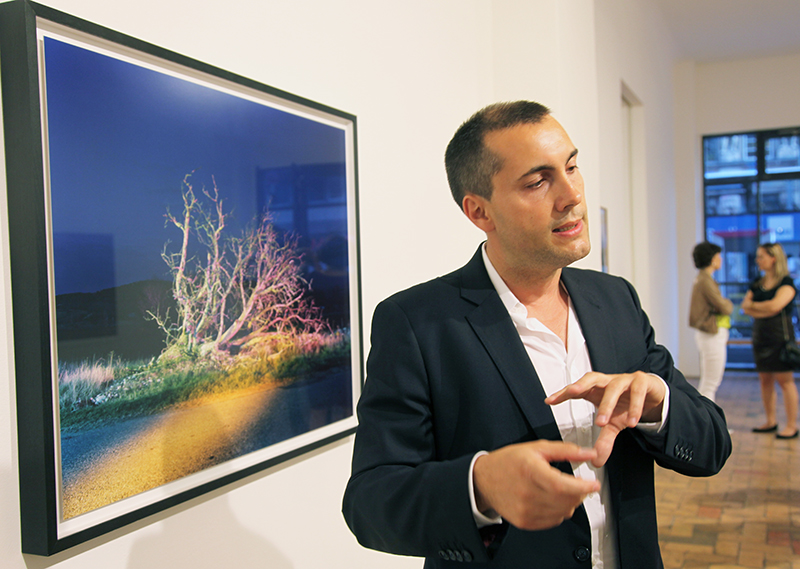empathy
Curating: Creating Dialogue Between Artworks

Sometimes when arriving at an opening it is hard to create a connection between the various pieces exhibited. When it comes to large group exhibitions, the variety is even broader. Yet we found one example where the artworks come together perfectly like a puzzle. Gyonata Bonvicini is one of the directors at Veneklasen/Werner, along with Harry Scrymgeour, and the curator responsible for “Several species of small furry animals gathered together in a cave and grooving with a pict,” the latest exhibition at the gallery. Named after Pink Floyd’s track in the 1969 album Ummagumma, the show features the work from twelve artists with different art-forms: drawing, painting, video, photography and installation.
GALLERIES: GIVE YOUR ARTISTS CENTER STAGE – JOIN THE SWARM TODAY!
The long-named track is an experimental piece of noises resembling rodents and birds, simulated by voices. The only verbal message is “That was pretty avant-garde, wasn't it?” Every sound is human-generated; no musical instruments were used to create any effects.
One of the first questions I address to Mr. Bonvicini is the reason for the choice of name. He mentions it was partly autobiographical: he is a life-long fan of the Pink Floyd and was attracted by the fact that it was a collection of many voices assembled together. The band was at the peak of their success when composing this song, which provided a certain frame of mixed self-consciousness but also willingness to explore. Likewise, the exhibition at Veneklausen/Werner looks to put together various artists and provides a thread for them to function together in the space.
On Life’s Endings & Beginnings
Several species of small furry animals… delves into the circular structure of life: beginnings, endings, presence, absence, perfection and decay of forms. One room, for example, features a drawing by Nicholas Byrne with the letter A. The curator points out the relationship between the shape of 'A' and the figure of an ox. The connection can be drawn to a piece located at the entrance by Aaron Curry, Phantom, which is a sculpture of painted wood featuring a hybrid between a bull and a human being. At the same time, a work by Moyra Davey showing a set of photographs of how a penny is transformed through time is there to remind us not only of beginnings but also of endings.
As mentioned before, the techniques shown try to create a limitless spectrum of time. The works of Andrea Büttner employ a typically medieval craft: woodcut on paper. Situated on the first room, they also help to shape the aura of the rust and renewal dynamics. Also located in the first room, a photograph by Gerard Byrne was the most attention grabbing piece. As Mr. Bonvicini explained, the artist traveled to find the place where Samuel Beckett got inspiration for the setting of his popular play, Waiting for Godot. As Beckett’s readers might recall, the first notes on the play say: “A country road. A tree. Evening.” The artist looked to stage an artificial theater of a hypothetical origin by placing different lights and creating an atmosphere to resemble that of Beckett’s imagination.
Last but not least, Dutch artist Manon de Boer presented a film called Dissonant, featuring dancer Cynthia Loemij. In this piece, the dancer listens to three sonatas for a violin solo and after the music is done playing, she dances and created a choreography only based in her memory. At the same time, there is a gap in representation – as there is in memory itself – and vision is interrupted.
The viewer, much like the dancer after the music, must reconstruct the pieces in order to make sense of it all. Dissonant makes a wonderful closure to the whole exhibition. There is always a gap between what the curator – and maybe the artist themselves – intended and what viewers perceive. However, if we look close enough and are able to gather the atmosphere of an exhibition, its blank spaces as opposed to its filled spaces, the position in which two works are placed together, the order in which rooms are presented, we will surely get closer to experimenting what the curator was searching for. In this case, it was the free usage of languages, techniques and the rhythm they created together. The Pink Floyd track may have seemed like a noisy mass of non-sense, but that is what experiments are for: opening new doors. In the case of this exhibition, the doors of our perception.
- Veneklasen/Werner – "Several species of small furry animals gathered together in a cave and grooving with a pict" Group Exhibition – July 6th to September 14th, 2013 – Tue–Sat: 11am–6pm [Price range of works: €3400 to €115,500]
Article by Sofía Martinelli
Be the first to write a comment.
Your feedback




